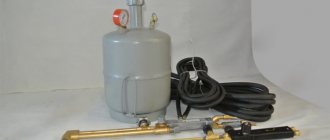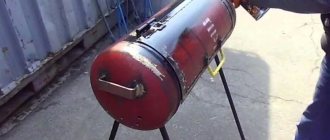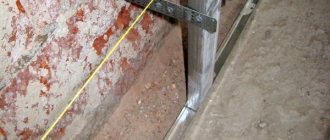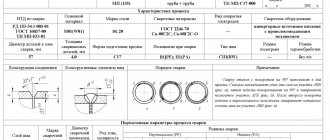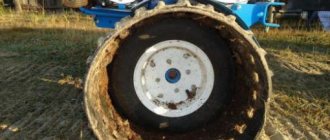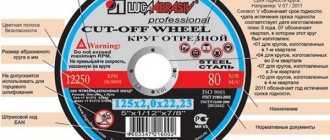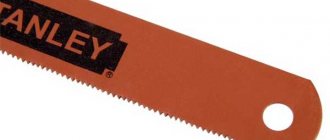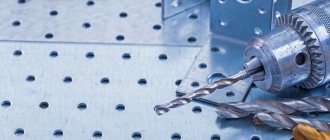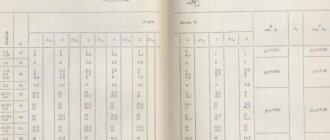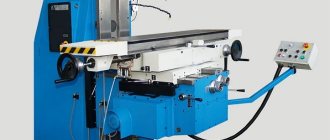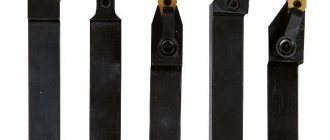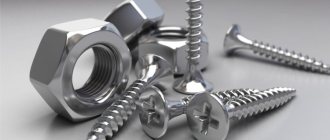SHARE ON SOCIAL NETWORKS
FacebookTwitterOkGoogle+PinterestVk
The metal crown has gradually taken its rightful place among home tools. The presence of this attachment in many cases allows you to save money and time on paying for labor and waiting for an invited specialist. Making a technical hole for a lock in a metal door or drilling round “niches” when tuning your favorite car becomes a completely feasible task for everyone.
When choosing a crown for metal, you should consider the presence of a centering drill
Ring crown for metal: technical features and method of application
Metal is a material that has recently significantly expanded its scope of application. More recently, it was associated with frames, floors, and rigid dimensional structures. Today, metal shelves, tables, and decorative elements decorate the interiors of many homes.
Core drills used for machining metal products are also known as annular cutters.
It is easy to cut a pipe, angle, or sheet using a metal saw blade. To connect workpieces into a structure, most often it is necessary to make a hole, which is made in the metal with an annular cutter - a crown. The crown design consists of the following elements:
- metal glass;
- cutting edge;
- shank.
The cutting part has the form of teeth, which can be a continuation of the metal cylinder body or be soldered fragments.
The bit is attached to the power tool using a shank that has a triangular or hexagonal shape (depending on the diameter size) to provide a strong, torque-bearing connection.
The operating principle of annular drills is based on the core milling method
Hole saws for metal differ in two respects:
- to size;
- according to the characteristics of the material from which they are made.
The range of dimensional diameters is quite wide - from 14 to 152 mm. As for the characteristics of the material, you should know that models are produced from hardened and alloyed steel, and the latter are particularly durable.
Carbide crowns for metal: good quality and affordable price
Despite the rather narrow scope of application of crowns, it is almost impossible to find a verified and clear classification of them. When labeling products, manufacturers use their own definition of differences. And different names can be used: “core drill”, “crown”, “hole saw”, “ring cutter”. And this is not the entire list.
The division into types based on the characteristics of the material of manufacture is even more confusing. The designation “20 mm metal crown made of alloy steel” corresponds to the truth, but does not give any idea about the product. All crown bits for metal are made of steel. Any steel has additives, that is, it is alloyed, supplemented with components that enhance or change its physical characteristics.
Carbide bits are used both in everyday life and in large-scale construction
The most common formulation is “high-speed steel bit.” This steel belongs to the high-alloy types; it necessarily contains the following substances: tungsten - 19%, vanadium - 2.6%, molybdenum - up to 3%, chromium 3.5-4.4%. This combination of components makes the cutter durable, resistant to wear for a long time, red-resistant, that is, not subject to deformation at temperatures up to 600 ° C.
Carbide crowns made from this material are widely used; they are used both in everyday life and in large-scale construction.
The products are of good quality and reasonable prices. The average size option - a 50 mm metal crown - will cost (depending on the manufacturer) from 600 to 1000 rubles.
Bimetallic crowns for metal: material features and method of application
Bimetallic – made of two types of metal. In the case of metal crowns, this is a combination of high-speed steel and cobalt, the content of which must be at least 8%. In this combination, the material acquires the qualities necessary for effective cutting of various types of metal, including stainless steel, aluminum, copper, brass, etc.
Bimetallic crowns are made of high quality high-speed steel alloyed with 8% cobalt
The diameter of these saw attachments can be very different, but most often tools of medium and large sizes (from 20 to 152 mm) are made using this method. Prices for these products vary depending on the size and manufacturer. A 20 mm nozzle will cost 150-250 rubles, a 35 mm metal crown – 350-500 rubles, large-size options 127 mm – 900-1300 rubles.
The main technical and operational characteristics of bimetallic crowns include:
- high quality material, allowing you to drill metal of any hardness;
- the presence of side holes to ensure waste removal and cooling of the cutting edge;
- the shape and arrangement of the teeth, facilitating the execution of neat cuts, without burrs;
- minimal (almost imperceptible) vibration during operation;
- the presence of a shank that makes it possible to attach the attachment to power tools of various power.
Bimetallic crowns - made of two types of metal
Helpful advice! Bimetallic crowns are most often used to make holes in hard and thick metal. When choosing an attachment, be sure to pay attention to its compliance with the power tool you plan to use.
Diamond bit for metal for drilling stone, concrete, ceramics
The first diamond crowns had a steel body with natural stones inserted along the cutting surface. It was a very effective tool, but it cost a lot of money. Modern industry produces artificial diamonds, which in terms of performance characteristics are not inferior to natural ones, and therefore are actively used for drilling and cutting various materials.
Two types of diamonds are attached to the tooth-shaped edge: scoring and volumetric. The cutting itself is carried out by the latter. Scoring blades are located on the inner and upper parts of the end part; they serve to protect the teeth from wear.
Diamond crowns are quite expensive tools. For example, a 35 mm crown will cost 300 rubles. You should not work with a similar attachment on metal; it is intended for hard stone: concrete, granite, marble, etc. If there are metal inserts in concrete or ceramics, then this version of a core saw will be a suitable tool. The crown will confidently pass through crumbling layers and easily cut metal elements encountered along the way, preserving the working surface.
The diamond bit is designed for hard stone: concrete, granite, marble
Helpful advice! Diamond coating on crowns can be different. Therefore, when choosing a nozzle for drilling stone with metal inserts, you should correctly assess the thickness of the latter and select an annular cutter with a suitable cutting end
About the selection rules
Crowns, which are made of fast-cutting steel, are characterized by increased elasticity. Therefore, they are used for processing steel alloys that are not very strong. Of course, if the hole diameter does not exceed 35 millimeters. At the same time, the special design of the crowns allows you to avoid frequent breakages.
In other words, if you need to process a durable steel part in the form of a hole that is larger than 35 millimeters, then you will need crowns equipped with carbide tips. Such attachments have a significantly increased working life. Especially when compared with conventional metal cutting tools.
Another important criterion that must be taken into account during the selection process is the geometry of the processed products. The characteristics of the material from which these products were made are also important. You need to understand that products of different thicknesses and different metals require different nozzles.
How to choose a drill for metal bits
A very important point to ensure the normal operation of the annular cutter is that the attachment matches the power tool used. Most often, drills are used as a rotating device. They have different technical characteristics. Here you need to pay attention to the following indicators:
- The power of the drill directly depends on the diameter of the bit: the larger it is, the more powerful the power tool is needed. For example, for a 25 mm metal bit, a 600 W drill is suitable.
- Possibility of adjusting the speed. The drill will be used for more than just drilling, so it is extremely important to set the desired spindle speed. Small-volume crowns require a significant number of revolutions; for large diameter diameters, the rotation speed must be reduced.
- Correspondence of the shape of the bit shank to the type of chuck. Chucks can be of two types: key and quick-release. For the first, you need a special key with which you can fix the nozzle (this option is considered more reliable.) The second is much simpler - you can fix the nozzle with one hand.
High power drills are used to drill holes using crowns.
The 22 mm metal bit does not require changing the spindle speed during operation. It is quite possible that the load on the cutting edge will increase due to the passage of a harder layer of material. To work in such conditions (drilling layers of different densities), a drill with a function to maintain frequency under load (constant electronics) can be a convenient option. The power tool will adjust the speed to suit specific conditions.
Types of annular cutters
There is a wide variety of annular cutters for metal on the modern market, which can be divided into the following categories:
- core drills, designed for equipping magnetic drilling machines and characterized by the highest strength;
- metal cutters made of high-speed steel that do not have any additional coating on the cutting part (some of their models, characterized by increased resistance to wear and impact loads, are made from special grades of steel containing up to 5% cobalt);
- metal carbide crowns, which can have a different number of soldered cutting teeth made of carbide.
Core drills with pusher
Whatever category core drills fall into, they are all produced with standardized shanks, which allows them to be used in conjunction with almost any equipment.
Financial Benefits and Empowerment: Metal Core Sets
If the question arises of choosing a crown for making holes in metal, it means that a lot of things in the house are done with your own hands. What should you decide on: buy an attachment for a specific single purpose or buy a set, looking into the future and anticipating the need? In case of an uncharacteristic isolated case, it is worth focusing on a separate product. Moreover, it would be useful to weigh and calculate what quality is worth paying attention to.
Even for a non-professional who wants to have a certain arsenal of household tools, it is better to prefer a set of metal bits for a drill. Advantages of purchasing this kit:
- the ability to make holes of different diameters by changing only the annular cutting part;
- no need to waste time searching for cutters of different diameters;
- cost savings: a set of crowns costs much less than attachments purchased separately;
- Hard plastic cases in which the elements of the sets are placed provide convenient and reliable storage of the tool.
A set of crowns costs significantly less than attachments purchased separately
If you try to estimate the financial benefits of purchasing a set, the calculation will be approximately as follows: the price of a 40 mm metal crown “Anchor” is 270 rubles, a set of 5 similar cutters from this manufacturer costs 760 rubles. The price of one nozzle (on average) is almost two times less.
Sets of crowns for metal can consist of 5, 8, 10, 12, 13 units.
Helpful advice! When purchasing a set of metal crowns, you need to pay attention to the presence of a centering drill in the kit. Its absence will not allow the nozzle to be installed exactly in the center on the surface of the material.
Design features and main parameters
A core drill for metal is a rather complex structure consisting of the following elements:
- directly to the working crown itself;
- pilot drill;
- shank;
- connecting screws.
Core drill device
To assemble such elements into a single structure, a pilot drill is inserted into a metal shank and connected to it with screws. Then a pilot drill with a shank is installed in the crown and the resulting structure is also fixed with screws. The cutting elements of such drills are teeth made of hard alloy, located on the working part of the tool with an uneven pitch.
Certain modifications of core drills come with a pusher that performs several important functions
The presence of carbide teeth on the cutting part, the hardness of which reaches 68 units on the HRC scale, provides such a drilling tool with the highest wear resistance and long service life. To facilitate the processing process performed with core drills, as well as to prevent overheating of their cutting part, coolant is used during the drilling process, which is supplied through the outer grooves of the tool.
The use of carbide bits for metal work makes it possible to obtain holes in the diameter range of 12–150 mm and with a depth of 35–50 mm.
Carbide drill bits for cutting holes in sheet material (short type). Supplied complete with center drill, shank and ejector spring
Universal mobile installation: magnetic drilling machine
A magnetic drilling machine is one of those devices that, despite their simple design, are highly efficient and cost-effective. Compared to a stationary drilling rig, it has a number of advantages:
- has no restrictions on the placement of holes;
- lightweight, mobile;
- inexpensive.
Magnetic drilling machines are designed for drilling, milling and threading in metal workpieces
On a stationary machine, it is possible to make only small holes, since the distance between the crown and the working surface does not make it possible to place large workpieces. The magnetic device can be fixed to any metal plane using a special sole.
Such machines have different functional purposes. Using a 32 mm metal crown (and bits of smaller diameters) you can make a hole in thin material. Circular cutters from 50 to 150 mm with a reinforced design are used for thicker metal materials.
Related article:
Wood crown: sizes and types of attachments, application features
Wood crown. Device and principle of operation. Types of hole saws. Features of operation of nozzles of various diameters. Bosh crowns, “Bison”, “Enkor”.
The magnetic part of the machines is quite powerful, it reaches 26 kN. This allows you to install the tool not only horizontally, but also at an angle, even vertically. If the surface is not level enough, the magnetic field does not reach the required value, additional clamps are used to secure the machine.
Magnetic drilling machines are more often used to make holes in large structures, so metal crowns of 50 mm or more are the most common attachments for such devices.
The machines are equipped with electric and pneumatic drives
A proven, reliable tool: Bosch metal drill bits
One of the most popular are Bosch metal crowns. Most of the products produced by this company are bimetallic, that is, made of two types of metal: the body is made of high-speed steel, and the teeth are soldered and have a slightly different composition, which includes cobalt.
The diameter of the nozzles is very different, but the step is equal to one inch: the minimum size is 9/16, that is, 14 mm, the maximum is 6, which corresponds to 152 mm. Some sizes may not be found in the Bosch crown line.
Bosch models have a standard fit of 1/2 or 5/8 inch, so the bits are compatible with many types of power tools. The Power Change adapter is used as an adapter. Replacing the annular cutter is not difficult and does not take long; to do this, remove the outer race - the adapter will push the crown out.
It is very important to maintain the required number of revolutions. A 29 mm nozzle requires a frequency of 400 rpm, and a 40 mm metal bit requires 200 rpm. These requirements significantly extend the service life of the nozzles.
Bosch crowns are made bimetallic, that is, made of two types of metal
As for the price of Bosch annular cutters for metal, it should be classified as moderate. A crown of medium diameter (38 mm) will cost about 800 rubles. Although the cost of individual products may exceed this figure. This company also offers sets of hole saws. A set of 11 bimetallic products costs an average of 8,000 rubles.
Metal crowns “Bison”: application features, prices
Metal crowns “Zubr” are domestic products. Although it should be noted that a significant part of them are made in China. Analyzing reviews on social networks, we can conclude that approximately 30% of users have complaints about the quality of the attachments. Nevertheless, the majority evaluates the tool as reliable and fully justifies the operational capabilities declared by the consumer.
The crowns are mostly bimetallic, with a wavy arrangement of teeth. The depth of the nozzles is standard – up to 40 mm. Size range of diameters – 14-152 mm. The drill bits from this manufacturer have side holes for chip removal, which makes the drilling process more comfortable. The holes after the “Bison” crowns are neat, with a smooth inner surface and smooth outer edges.
The attachments are inexpensive, the smallest (14 mm) will cost 150 rubles. The price of a 110 mm metal crown will average 800 rubles.
The holes after the “Bison” crowns are neat, with a smooth inner surface
Important! The service life of these crowns largely depends on the method of operation. From application experience (information taken from user reviews) it follows that you should not cut metal with a thickness of more than 2 mm with Zubr annular cutters, or it is necessary to use additional water cooling.
High-quality Chinese version: metal crowns Fit
Fit crowns are made in China. Canadian technologies are used during production. The company has many large branches on the Russian market. Like many other manufacturers of similar products, the main part of the crowns are bimetallic products.
Fit circular cutters can be classified into the middle price segment, which makes them quite popular. A 25 mm metal crown will cost 400 rubles, 30 mm – 500 rubles, 35 mm – 600 rubles.
Small and medium-sized bits have a triangular shank, each model is equipped with a centering drill. A distinctive feature of crowns from this manufacturer can be considered the absence of an external protective coating. This should in no way be regarded as a disadvantage. The chrome vanadium body does not need this addition. The absence of traces of damage to the coating, although it does not affect the result of the instrument, helps to preserve the aesthetics of the product. As a result, the process of working with a crown becomes more comfortable.
The ring bit for metal FIT is used for drilling holes in stainless steel
It should be noted that a metal thickness of 2 mm is not the limit for these nozzles. For example, with a 60 mm Fit metal bit you can drill a 3 mm sheet without harm to the cutting edge and without additional cooling. The shank of bits larger than 32 mm is hexagonal, which allows you to firmly secure the cutter body to the power tool.
Metal crowns "Anchor": sets and individual attachments
"Enkor" is a domestic trading and manufacturing company that has tens of thousands of different products, including metal crowns. It is worth noting that among the nozzles offered by this manufacturer there are both bimetallic models and simpler ones made of carbide material.
This choice allows buyers to find a suitable option in accordance with their financial capabilities. A 22 mm carbide metal bit will cost a little more than 100 rubles.
The dimensional parameters of Anchor nozzles can be considered standard: depth – up to 40 mm, diameter – from 14 to 152 mm. The crowns can come either complete with a holder and a centering drill, or separately - the main body with a cutting edge. The latter option is convenient for those who already have ring cutters of other sizes. The product is also suitable for cases where there is a need to replace the bit due to significant wear on the cutting edge.
Anchor nozzles are made from both bimetallic models and carbide material
Helpful advice! For more comfortable use, it is worth purchasing Anchor bits with a push-out spring, which does not allow the drilled fragment to get stuck in the bit body.
Crown sets from this manufacturer are also an available option. For example, a set of 9 attachments can be purchased for only 3,250 rubles. The minimum diameter of the crowns is 19 mm, the maximum is 64 mm. The set contains a key, two adapters and a centering drill. The small size of the transport case makes storing the tool convenient.
How are core drills marked?
By the markings, which are necessarily applied to the packaging of core drills, you can find out all their most important characteristics. Thus, the marking contains the following information:
- trademark or name of the manufacturing company;
- brand of material of manufacture or letter designation, by which you can determine that this is an annular drill for wood, metal or concrete;
- the basic geometric parameters of the drill, allowing you to determine the size of the hole made with its help.
In addition to the logo, the diameter and working length are applied directly to the core drill. The purpose and specifics of the nozzle are displayed on the packaging or in the accompanying documentation
Metal crown: tips for proper use
Almost all new instruments have an attractive appearance. On the pages of online stores you can find a meaningful description of the product, sometimes even supported by positive customer reviews. In order not to be disappointed with the purchase, you need to seriously study the capabilities of the tool. You can evaluate core drills for metal in the following order.
The centering drill must be included with the crowns
- You need to make the right choice; to do this, you should carefully read the labeling information. The packaging must indicate the dimensions, country of origin (which to a certain extent indicates the quality of the product), material of manufacture, features of accessories and devices. If the marking does not provide complete information about the annular cutter, there is reason to doubt the quality of the tool.
- During use, do not neglect the manufacturers' recommendations. Using the crown for purposes other than intended will result in damage to the instrument.
- If the kit does not include a centering drill, it must be purchased taking into account certain requirements. For example, the drill bit of a drill attachment must be cross-sharpened, otherwise instantaneous and accurate centering will not be possible.
- The need to regulate the number of revolutions was discussed more than once in the article. It should be emphasized that this condition is perhaps the most important for increasing the service life of metal crowns.
With the correct selection and use of crowns, a hole in metal can be made in a matter of seconds. The tool is applicable for various household and industrial purposes. Compliance with technical requirements can extend the service life for a long time. Conversely, one thoughtless use can cause defects that will make the crown unsuitable for use.
Advantages of core drills
Core drills for metal, when compared with conventional ones, have a number of advantages.
- The design of annular cutters for metal work is designed in such a way that the hole is cut along its contour, which does not require equipment with a high-power drive.
- By drilling with an annular cutter, you can obtain holes with high internal surface roughness. This cannot always be achieved when using a classically designed tool.
- Core drills are installed on various types of equipment. In particular, they are used not only on drilling machines, but also on milling and turning machines.
- Drills of this type can be used in conjunction with other tools, that is, they can be used to perform multi-tool processing.
- The area of contact between the cutting edges of the core drill and the workpiece is quite significant.
- In one pass, a core drill allows you to remove a large amount of material being processed.
- In order to process the metal being processed into chips, significantly less energy and power of the equipment used is required.
- Due to the fact that annular cutters are made of high-speed steel, drilling with their help is performed with high productivity.
- The drilling process is carried out not only at high speed, but also with exceptional precision.
- This type of tool is highly economical and ergonomic to use.
- Annular cutters create a minimal amount of noise during processing.
- The high productivity of using such a tool is also ensured by the presence of a large number of cutting edges on its working part.
An annular drill allows you to produce through holes in metal products, the diameter of which is in the range of 12–150 mm.
Design and characteristics of core drills
The metal drill bit has a rather complex design compared to conventional twist drills and consists of the following elements:
- Shank. Designed for tight fixation in the chuck of a hand tool or in the spindle of a metal-cutting machine. It has a configuration and cross-sectional shape corresponding to the type of equipment used. It can have a cylindrical, hexagonal shape or have special grooves. Weldon type shanks are commonly used on magnetic drilling machines.
- Center drill. Necessary for precise centering of the core cutter by cutting into the surface layer of the metal being processed. It is fixed in the shank using special clamping screws. It moves back during operation and returns to its original position using a central spring.
- Drill bit. Connects to the shank with a clamping screw. The main working part of the tool. The assembled cutter is usually not made of high-speed steel, but has welded carbide teeth on the cutting end.
- Guide centering rod. This design element is found in an annular drill installed on specialized industrial drilling machines. It is used instead of a center drill and is designed to center the main tool. Also, when starting work, the rod opens the coolant supply valve, which is directed to the workpiece cutting zone. At the final stage of cutting, the rod pushes the cut metal out of the body of the part.
Metal core drills for drills usually have a simpler design and can only consist of a shank and a crown itself. They can be collapsible or integral. But you need to understand that using a drill you can only work with relatively weak unalloyed steels or soft alloys. The parts should not be thick-walled.
Advantages and disadvantages
Core drills have become widespread in metalworking due to the combination of a number of positive properties, among which the following can be highlighted:
- Using this tool, you can make holes with a diameter of up to 200 millimeters using simple equipment. While conventional twist drills cut metal along the entire cross-section of the hole, core drills process it only around the perimeter. Accordingly, the amount of metal cut out is significantly less. Therefore, there is a significant saving in energy spent on work.
- When drilling large holes with conventional drills, you must first make pilot grooves of small diameters. Then the entire volume of material located inside the future hole is processed into chips. A core drill makes a hole in one operation and much faster. Thus, their use leads to savings in work time and increases process productivity.
- The configuration of the cutting profile of the core drill is favorable for obtaining high roughness values of the inner surface of the hole. It is very difficult to achieve such a clean surface with conventional drills. To do this, it will be necessary to additionally process the metal using other technological machining operations.
- Ring drills for metal made of high-speed steel will last a very long time, since they can be sharpened many times. Moreover, the cutting edges can be restored as long as the gradually decreasing length of the tool allows this. Of course, the cutting profile of the teeth has a rather complex configuration, and therefore proper sharpening requires a certain skill level of the master or the presence of a drawing that can be used as a guide.
- Using annular drills, you can drill holes not only on flat surfaces, but also in parts with a complex curved surface. Working with twist drills in such cases involves many preparatory operations and the use of various tricks. You can easily drill pipes with crowns. Processing of pipes of large diameters, which cannot be placed in the machine, can be easily carried out using magnetic drilling machines with a core drill mounted in a chuck. High-speed steel drills are well suited for this.
- Due to their design, drill bits are significantly lighter in weight compared to traditional tools. This difference is especially large at large diameters. The small weight allows you to work with core drills on small drilling machines and even on hand-held power tools.
- It is much easier to carry out machining operations using a core drill for metal than with a twist tool. This tool, even without preparatory operations, is well centered and allows you to obtain an even hole perpendicular to the surface.
- When installing special prefabricated core drills on metalworking machines, it is easy to achieve good cooling and lubrication of the tool. The coolant is supplied to the processing zone through an internal hole in the tool, and therefore reaches the cutting edge in sufficient quantity.
Despite the huge number of the above advantages, the ring drill for metal also has several significant disadvantages, among which the following two can be distinguished:
- Using this tool, you can only make through holes in the metal. To make blind holes you will have to use a different cutting tool.
- More common are core drills, the cutting part of which is made of welded carbide teeth. Such a tool cannot be sharpened, and therefore, after its cutting properties have deteriorated, it becomes unusable.
Table of contents
Metal core drills are tools, also called annular cutters, that are distinguished by their ability to produce holes with a large diameter and depth. Thanks to this cutting tool, you can make holes in a matter of seconds. The core milling method requires 4-12 times less energy investment, so less industrial drive power is required. Used to drill through holes. You can see what the structures look like in the photo of core drills.
photo: core drills for metal
Advantages of drills
Metal core drills have a number of significant advantages that set them apart from other cutting tools, namely:
- Annular cutters have a special metal core drill design that grinds down the metal around the hole and therefore does not require the use of an industrial drive.
- Thanks to the device, it is possible to obtain very high roughness values that cannot be achieved when drilling with conventional tools.
- The units can be used in parallel with other tools, for example, drilling, milling and turning equipment is suitable.
- Multi-tool processing is possible.
- The presence of a significant area of contact with the workpiece.
- Significant volume of material removed.
- Lower costs for processing metal into chips.
- Manufactured from high-speed steel, which ensures high performance.
- Greater speed and accuracy of the process.
- Cost-effective and completely ergonomic.
- No noise during operation.
- Cutting edges are available in large quantities.
Core drills for metal allow you to make through holes with a diameter of 12 to 150 mm.
Drilling with core drills: features of choice
A set of core drills requires the following types of tools: a carbide core drill with teeth and high-speed steel. When deciding on the choice of cutting device, it is necessary, first of all, to determine the diameter of the hole you need.
photo: drilling with core drills for metal
If the drilling diameter is 30-35 mm, then a high-speed device will suit you. This is also an excellent option if the strength of the steel is also not the highest. This installation is characterized by increased elasticity, it has a lower risk of tooth breakage, and it is also more profitable to purchase. If the diameter is greater than 35 mm, or if the steel has high strength, then you need to select devices with carbide teeth. It has a stronger resource.
Important: the main criterion for choosing a design is the material that you plan to process. Different settings are suitable for different materials. The material can be thin-walled sheet metal, structural, high-alloy and stainless steel, magnesium and titanium steel, non-ferrous metals such as duralumin.
Types of cutting tools
There is a wide range of devices on the market. You will certainly be able to find the necessary tool to solve the drilling task. The following models exist:
- Core drills for magnetic drilling machines have the highest strength.
- Made from high-speed steel – with or without a special coating that increases wear resistance.
- An annular core drill - has a different number of teeth, as well as soldered carbide plates.
All designs are made with universal shanks - this means that they are suitable for any equipment.
There are also high-quality high-speed steel installations. They contain 5% cobalt, which ensures high durability and shock resistance.
Dimensions and characteristics of core drills for metal
The device consists of the following elements:
- Crowns;
- Pilot drill;
- Core drill shanks;
- Connecting screws.
The pilot is secured using connecting screws when inserted into the shank, then the assembled structure is inserted into the crown and secured again with connecting screws. The cutting element is carbide teeth or plates that are unevenly spaced and are subject to stepwise hardening. The presence of carbide teeth ensures the possibility of continuous operation of the device, and also ensures the achievement of a cutting edge hardness of 68 HRC. They can be used in conjunction with lubricating coolant to facilitate the drilling process. Coolant is supplied through external grooves during operation of the device. All devices can sharpen core drills.
Core drills for metal diameters have a range of hole diameters that can be drilled using this element - this is 12-150 mm. The length of the installations can be from 35 to 50 mm. Let's look at the dimensions using Karnasch devices as an example.
| Series | Diameter, mm | Drilling depth, mm | Shank, mm |
| Karnasch Gold-Line | 12-60 | 30,55,80,110 | 19 |
| Karnasch Hard Line | 65 | 110 | 19 and 32 |
| Karnasch Rail Line | 18-36 | 30 | 19 |
| Karnasch Blue Line | 18-60 | 110 | 19 |
Marking
Core drill 110 is subject to marking. Products with a diameter below 2 mm are not marked, above 3 mm - the brand and thickness of the device are indicated. If the installation is very large, the manufacturer, steel composition, and other characteristics are indicated on it. On the product packaging you can also find detailed information about the device and its characteristics.
Karnash brand tools
Today it is not difficult to choose and purchase core drills to solve any technological problem, since they are presented on the modern market with a wide variety of types and brands. These can be core drills for wood, as well as more durable and wear-resistant tools for concrete, cutters for making holes in metal products and structures.
Among specialists who often work with core drills, products manufactured under the Karnash brand are popular. The popularity of these core drills is facilitated not only by their exceptionally high quality, but also by the fact that they are available in a wide range, from which you can choose a tool to solve a specific task.
Karnash core drills
Thus, among the products manufactured under this brand, we can distinguish core drills of the following series:
- Gold-Line, made of high-speed steel HSS-XE, on the surface of which a wear-resistant coating is applied using Gold-Tech technology;
- Hard-Line, the cutting part of which is made of Swedish-made carbide inserts (the expanding spiral groove of core drills in this series simplifies the removal of chips from the processing zone);
- Rail-Line, the working part of which is also equipped with carbide inserts with multi-stage sharpening of cutting edges (with the help of tools in this series, railway rails are drilled);
- Blue-Line and Blue-Line Pro, used for drilling hardened railway rails, cast iron, aluminum and stainless steel.
Characteristics and parameters
The capabilities of a core drill for metal depend on its characteristics:
- Crown diameter. The dimensions and other characteristics of core drills depend on this indicator. Diameter range - from 1.4 to 18 mm.
- Drilling depth. Typical value is 40 mm.
- Fixation type.
- Shank dimensions.
- Metals from which nozzles are made.
Most often, core drills are made of carbide steel, the teeth are made of pobedite.
Many crowns are sold without center drills. It is necessary to check its availability in advance. It will help you create the most accurate holes without deviations from the required dimensions.
